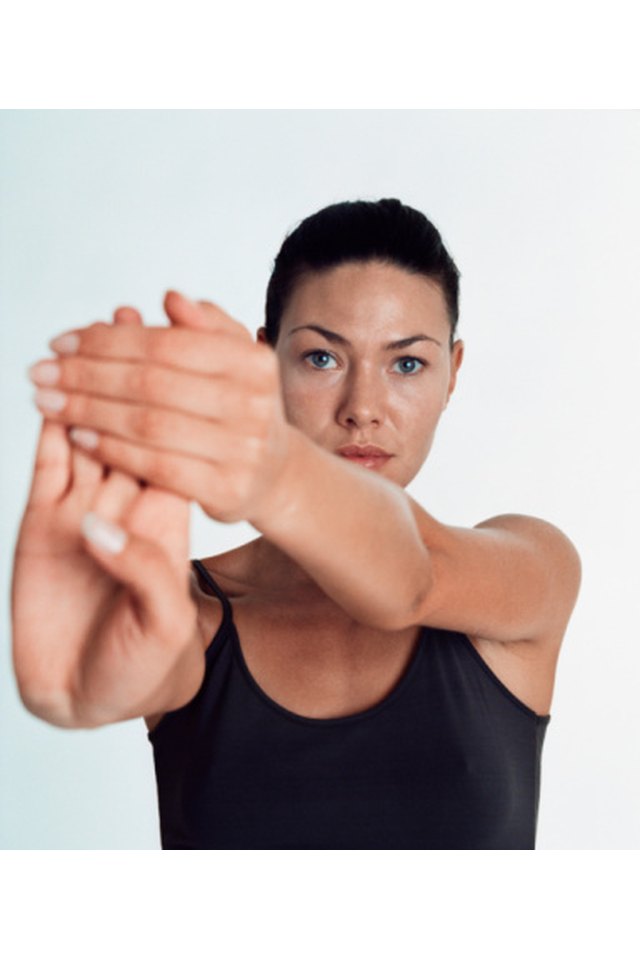Exercises for a Finger Deformity

Finger deformities may be caused by injury to the tendons and muscles in your fingers, or medical conditions such as rheumatoid arthritis that result in joint inflammation and damage. The primary goal of rehabilitation exercises is to ensure that the tendons, joints and muscles in your fingers are in balance. Your physician will recommend some stretching and strengthening exercises to promote range of motion, and maintain alignment and function in your fingers and hands. Consult with your physician before starting an exercise program.
Finger Passive Range of Motion
Mallet finger, according to Merck Manuals, is a deformity in which the fingertips are curled inward, and cannot be straighten. This type of finger deformity is typically caused by damage or tears to the tendons in your fingertips. Passive range of motion may be recommended by your physician to maintain flexibility and range of motion in your fingertips. Begin by extending your affected hand forward. Use your uninjured hand to bend your affected hand. Next, gently begin to straighten your affected finger as much as possible. At the apex of this finger extension, hold for five seconds. Perform one set of 10 repetitions three to five times a day to promote flexibility in the joints of your finger.
Finger Extension
Another exercise that promotes joint health and rehabilitation of mallet finger is finger extension. Begin this exercise by standing upright in front of a table. Place your affected hand on the surface of the table with your palm flat on the table, and your fingers extended. Lift each finger, one at a time, as far as possible off the table. At the apex of the finger extension, hold for five seconds and relax. Perform one set of 10 repetitions, three times a day.
In addition to finger extension, picking up small objects such as coins and marbles with your injured finger and thumb promotes joint health and flexibility. Squeezing a rubber ball and holding each squeeze for five seconds will also promote range of motion and flexibility in your injured hand.
Finger Adduction and Abduction
Swan-neck deformity is finger deformity caused by rheumatoid arthritis. Swan-neck deformity is characterized by bending at the base of your finger, straightening of the middle joint in the affected finger, and bending of the outermost joint the finger. Untreated mallet finger may be also be the cause of the finger deformity that results in severe disability. Finger abduction and adduction may be recommended by your physician to rehabilitate the affected finger. Begin by standing upright and bending your elbow to a 90 degree angle. Bring the arm of your affected finger to the side of your body and spread your fingers as wide as possible. Hold for five seconds and bring your fingers back together. Perform one set of 10 repetitions, three times a day to promote the circulation of oxygenated blood to the fingers and promote joint health.
Finger Flexion
Swan-neck deformity can inhibit normal bending of the affected finger. This exercise promotes joint health and flexion in your fingers. Begin by placing the elbow of your affected hand on a flat surface such as table, and lift your forearm straight up. One at time, slowly bend your fingers to touch the middle of your palm. At the apex of each finger flexion, hold for five seconds. Perform one set of 10 repetitions, three times a day to promote flexion and range of motion in your fingers.
References
- Merck Manuals; Deformities: Hand Disorders; March 2008
- Summit Medical Group; Mallet Finger (Baseball Finger) Rehabilitation Exercises; Tammy White, MS, PT, Phyllis Clapis, PT
- American Academy of Orthopaedic Surgeons, OrthoInfo. Mallet Finger (Baseball Finger). Updated March 2015.
- Bachoura A, Ferikes AJ, Lubahn JD. A review of mallet finger and jersey finger in the athlete. Curr Rev Musculoskelet Med. 2017;10(1):1-9. doi:10.1007/s12178-017-9395-6
- Cheung JP, Fung B, Ip WY. Review on mallet finger treatment. Hand Surg. 2012;17(3):439-47. doi:10.1142/S0218810412300033
- McKeon KE, Lee DH. Posttraumatic Boutonnière and Swan Neck Deformities. J Am Acad Orthop Surg. 2015 Oct;23(10):623-32. doi:10.5435/JAAOS-D-14-00272
Resources
Writer Bio
Danielle Stevens is a graduate of George Washington School of Medicine and is currently a resident fellow at Georgetown University Hospital. Stevens is interested in pediatrics and gynecology as well as pediatric surgery. Stevens has been writing professionally since 2008 for The American College of Obstetricians and Gynecologists, Words and Numbers, and Prime Inc.
